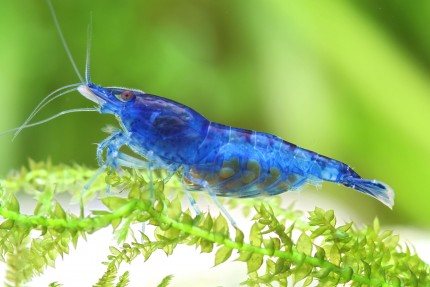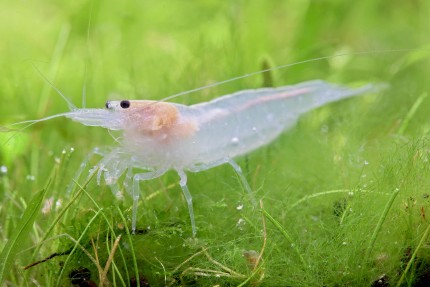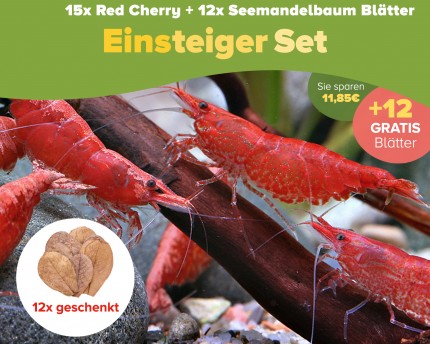| ab 1 | € 14,95* € 7,99* / Stk. | -46.6% |
| from 5 | € 14,95* € 7,49* / Stk. | -49.9% |
| from 10 | € 14,95* € 6,99* / Stk. | -53.2% |
incl. VAT plus shipping costs
Ready for shipment in 5 Day(s)
- Item no: 2777
Fast delivery times
All products are in stock with us!14 years of breeding experience
Let our team of experts advise you!High customer satisfaction
from over 3,000 reviews "| Difficulty: | for beginners |
| Propagation: | possible in fresh water |
| Origin: | German offspring |
| Coloring: | brown |
| Water values: | soft to medium hard |
Red scissor shrimp - Macrobrachium Inlesee - Macrobrachium peguense (planarian eater)
Macrobrachium peguense, often incorrectly referred to as Macrobrachium peguensis, is also known as Macrobrachium sp. Inlesee Burmese shrimp, or red scissor shrimp. It is extremely useful as it has been shown to be one of the few aquarium animals to eat planarians. Small snails are also eaten with great pleasure.
The Burmese shrimp is transparent, often with a light to dark brown pattern, and it grows up to 5 cm in size. Females are slightly bulkier than males, but have slightly finer claws and also remain a bit smaller. Unlike crayfish, the first pair of scissor bones in large-armed shrimp is relatively small, but the second pair of scissor bones is very prominent and large.
Macrobrachium peguense are easily reproduced in the aquarium. The females of the red scissor shrimp carry 20-40 eggs, which hatch after a few weeks into fully developed miniature shrimp that grow large in the freshwater aquarium. The parent animals do not particularly pursue their offspring, and with enough hiding places, the small Inlesee Burmese shrimp can be raised in an aquarium with the parent animals.
The red scissor shrimp feel comfortable in soft to medium hard water with a pH of 6 - 7.5. The water temperature should be between 20-30 degrees. Macrobrachium peguense should not be kept singly, species appropriate keeping is possible with a smaller group of at least 3 animals.
You can keep Macrobrachium peguense quite easily for example with dwarf shrimps like Red Fires and also with medium sized, non-predatory fishes together in the aquarium - but the requirements to the water values should match. Now and then it is possible that the Red Scissor Shrimp will eat a small shrimp or a careless juvenile fish, but usually it is quite peaceful and easy to socialize. Snails are eaten. Since the animals can be relatively territorial, plenty of hiding places are advisable. Also brown autumn leaves are very suitable as hiding places and also as permanent food.
The Inlesee Burmese shrimp is a distinct omnivore and even goes for planarians. Food of animal origin is preferred, but now and then the animals also nibble on foliage, which should be available as permanent food in the Macrobrachium aquarium. The red scissor shrimp loves to eat frozen food, but also fish food like flakes, granules and tabs, special shrimp protein food, normal shrimp food and rarely green food like stinging nettle
Our food recommendation: The soft granulate of the Natureholic MacroFeed consists of biologically balanced animal components that large-armed shrimps would find in nature in this or a similar way. This supports in a completely natural way the moulting, the development and a healthy growth of your fascinating large arm shrimps in the aquarium.
Our plant recommendation: For planting, use NatureHolic InVitros. These are free of snails, planarians and other unwanted co-inhabitants. Also free of algae spores, bacteria and fungi.
Expert Tip: We recommend for fish keeping the NatureHolic 3 Phase Liquid. The care set offers the best all-round protection for your animals. It ensures optimal conditions for successful breeding and keeping.
| Scientific name | Macrobrachium peguense (Tiwari, 1952) |
| German name: | Red scissor shrimp, Macrobrachium sp. Inlesee Burma, Burmese shrimp |
| Difficulty level: | suitable for beginners |
| Origin/Distribution: | Lake Inles, Burma |
| Coloration: | Body transparent to gray or also brownish with fine light brown to dark brown stripes and spots. Claws sometimes reddish, but often transparent |
| Age expectancy | up to 4 years |
| Water parameters: | GH 8 to 15, KH 6 to 15, pH 6.5 to 8, temperature 20 to 30 °C |
| Tank size: | from 54 l, well structured |
| Food | Protein food 2 to 3 times a week, otherwise also frozen food, fish food (flakes, granules and tabs), protein food, shrimp food(Natureholic Mainfeed), rarely vegetables or green food like spinach or nettle |
| Propagation | relatively easy, after 3-4 weeks up to 40 fully developed young shrimp hatch. Offer many hiding places! |
| Behavior | not very aggressive |
| Socialization | with dwarf shrimp and snails, which can be eaten though, with medium sized fish, not with crabs and crayfish. |
| Further information | Foliage for the aquarium + foliage list, Feed shrimp, crabs, snails & mussels properly, 10 tips for beginning aquarists |
- Item no: 2777
- EAN No.: 7427061478259
Entdecke die Garnelio Welt!
Garnelio gehört zu den größten Onlineshops für wirbellose Aquarientiere weltweit.
Viele Artikel gibt es exklusiv nur bei uns im Shop.














































